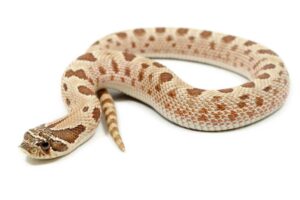Some animal facts are simply fun and interesting to learn, while others could literally save your life. If you want to keep one as a pet or there’s any chance at all that you might come across one, then you definitely want to know: are Hognose snakes venomous?
Hognose snakes are not technically considered venomous because they do not have a means of injecting toxins, although their saliva does contain a mild toxin. It is possible that they might bite, but they are unlikely to cause any serious damage.
Read ahead to find out just how dangerous Hognose snakes actually are, and what it might mean if you are bitten by one.
Table of Contents
What Does Venomous Mean?
The meaning behind the term “venomous” is a pretty important one when it comes to understanding the potential dangers of various animals – particularly snakes.
A venomous creature is one that produces venom and bites or stings in order to inject that toxin. This term is often confused with “poisonous”, which actually refers to creatures that contain a toxic substance in their body that will cause harm when they are ingested.
In simple terms: a venomous animal is one that injects toxins by biting or stinging, and a poisonous animal is one that is toxic to eat.
When it comes to Hognose snakes, the key part of the definition is actually about the injection. While they do have some toxins in their saliva, these snakes do not have a system that enables them to directly inject that toxin into your body and they don’t use it to cause harm – which means that it is not technically a “venom”, and Hognose snakes are not technically venomous.
How Venomous Are Hognose Snakes?
Although their status as “nonvenomous” animals might be based on a simple technicality, it does actually tell us a lot about how dangerous Hognose snakes are.
Firstly, the toxin that they do produce is very mild. It’s known as “Duvernoy’s secretion” and, unlike true venoms, it’s not used to harm or kill prey by most of the animals that make it. In fact, the reason why it is produced at all is still mostly unknown to science.
Hognose snakes have smooth teeth that do not contain any grooves for delivering toxins when they bite, and the glands that produce toxins for their saliva are pretty far away from their largest fangs. This is another indicator they don’t actively “inject” the toxin as a weapon or a defense mechanism.
Do Hognose Snakes Bite?
With all of that being said, Hognose snakes do still have teeth and their saliva does still contain some toxins. For the most part, though, they are pretty unlikely to use either of them.
Most Hognose snake species prefer to strike with their mouths closed or play dead to avoid confrontation. They are rarely aggressive and are usually pretty docile, which is one of the reasons why they have been popular pets for many years.
When threatened, they might hiss, and they can lift up their heads and flatten their necks like cobras, but they don’t bite very often.
That’s not to say that bites don’t happen, though. Usually, they occur when a snake confuses a hand for food, and you do need to know what to do when that happens.
What Should You Do If You’re Bitten By A Hognose Snake?
In small amounts, Hognose saliva is unlikely to cause any kind of serious harm to a human, but it has been known to cause swelling or tissue damage if it enters a large cut for a long period of time.
There have been no deaths recorded due to Hognose bites, nor any significant systemic effects, but you still need to respond in the right way.
- Stay calm and try not to panic or startle the snake further.
- If the snake has latched on, do not pull it off or it can cause more damage to you and/or the snake. Instead, pour some cold water on its face, or even some mint mouthwash.
- Gently wash the bite with water. If it has penetrated the skin, then you should apply an anti-septic and bandage it.
- If you notice any inflammation or swelling, you should visit a doctor and inform them clearly which species it was that caused the bite.
What Are The Different Kinds Of Hognose Snakes?
It might seem like all Hognose snakes are the same, but there are many different species under the Hognose umbrella. It’s not actually a species of its own; it’s just a common name for several species from three different genera.
The most common species of Hognose snakes are:
- Mexican hognose snake
- Gloyd’s hognose snake
- Western hognose snake
- Eastern hognose snake
- Southern hognose snake
- Speckled hognose snake
- Malagasy giant hognose snake
- Blonde hognose snake
- South American hognose snake
- Jan’s hognose snake
- Tricolor hognose snake
- Ringed hognose snake
It can be quite easy to mistake one species of snake for another, particularly in the wild. If you are bitten by a snake and you are not absolutely certain that the species is non-venomous, then you should seek medical attention straight away.
You might like to read this snake article – Click here
What You Need To Know: Are Hognose Snakes Venomous? (Don’t Get This Wrong!)
So, are Hognose snakes venomous? According to science, they are not. Although their saliva does contain a mild toxin, they are not considered to be venomous, and their bite does not cause significant harm to a human. In fact, they rarely break the skin.
These snakes are also not fighters. They’re calm and docile most of the time, preferring to play dead and hide than get aggressive.
It can be hard to tell different snakes apart, though, so you should always seek medical help if you are bitten and you are not 100% sure what species you are dealing with.










